Common buckthorn (
Rhamnus cathartica) is one of the most damaging plants to woodlands in the upper Midwest, northern Great Lakes region and New England states. It thrives in the shade of deciduous tree canopies, creating a dense thicket in the forest understory. This dense growth shades out the woody native plants in the understory as well as the herbaceous ground layer. Common buckthorn is listed as a noxious weed in Connecticut, Iowa, Massachusetts, Minnesota, New Hampshire and Vermont, according to the U.S. Department of Agriculture.
The most important thing you can do is to learn how to identify common buckthorn to determine if it’s growing in your landscape, then come up with the best control method based on the quantity and size of your plants, and the amount of time you have to put toward controlling them. There are a number of native plants that grow in the same understory and woodland edge habitat that can be planted once common buckthorn is removed. Find out about some of these replacements below.
Live in another region of the U.S.? Browse plants native to more regions of the U.S.

Eli Sagor
Introduced in America as an ornamental plant by the horticultural trade, common buckthorn was prized for its effectiveness as a hedge. Birds fed on its dark fruit, then dispersed the seed far and wide, moving this plant from homeowners’ yards to natural areas, where it’s one of the most prominent invasive plants in woodlands.
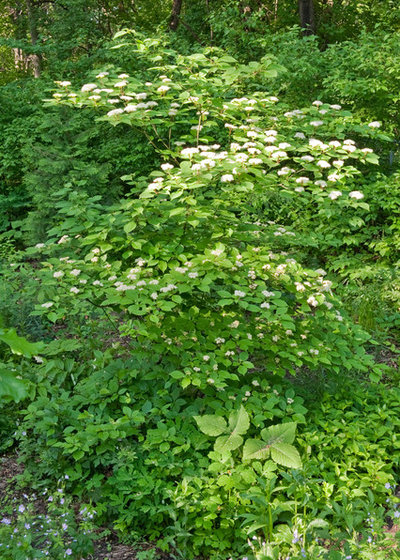
Holm Design & Consulting LLC
What to Plant Instead of Common BuckthornAlternateleaf DogwoodCornus alternifoliaNative to eastern North America from Minnesota eastward to Maine in the north and from Arkansas eastward to Georgia in the south
This is a flowering multistemmed shrub or small tree that grows in partially shaded woodland understories and along the edges of woodlands in the same or similar sites that common buckthorn occupies.
Alternateleaf dogwood has a horizontal branching habit, white flowers in the spring and dark blue fruit in the fall that birds devour. It grows well in partial shade and works well as a specimen plant or along the east or north side of a house foundation.
Water requirement: Moderately moist soil
Light requirement: Partial shade
Mature size: 25 feet tall
Planting notes: It can be used in any partial shade location with moderately moist soil.
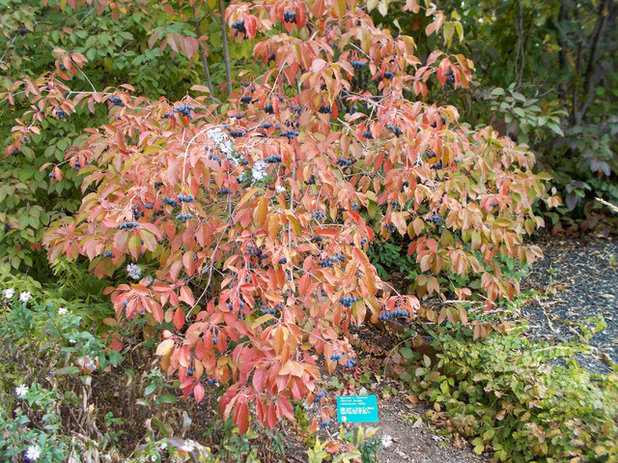 Photo by Andrey Zharkikh
Photo by Andrey Zharkikh
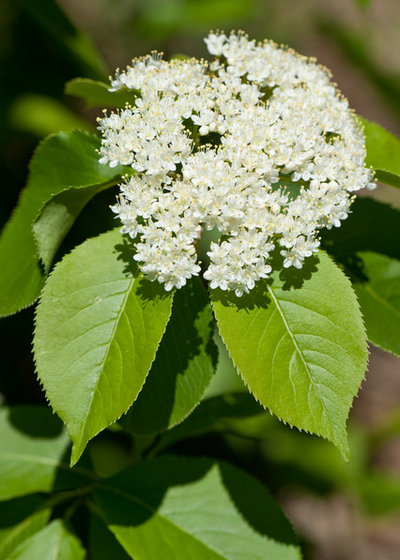
Holm Design & Consulting LLC
Nannyberry (
Viburnum lentago)
Native to north central and northeastern North America from Montana eastward to Maine in the north and from Wyoming to Pennsylvania in the south
Nannyberry is a large spring-flowering native shrub that grows along the edge of woodlands in partial sun and in the understory in partial shade. It has an upright form similar to common buckthorn and attractive glossy green foliage that turns brilliant red or copper in the fall. The flat-topped creamy white flowers are large and attractive, and they supply pollen and a small amount of nectar to visiting insects.
Water requirement: Most soil types from moist to mesic-dry
Light requirement: Partial shade
Mature size: 25 feet tall
Planting notes: Nannyberry is a nonaggressive multistemmed suckering shrub that will slowly increase in girth. It can replace common buckthorn in the understory of trees or on the edge of a woodland.
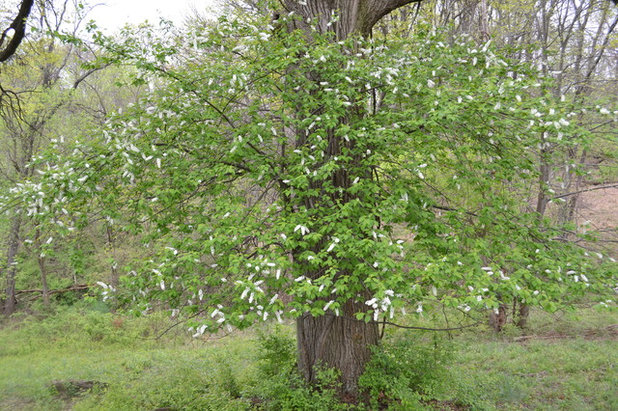
Solomon Gamboa
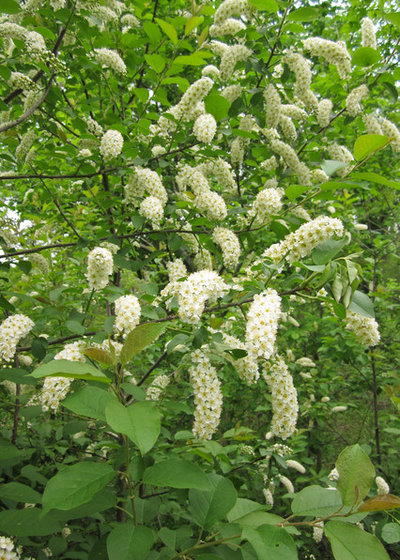
Holm Design & Consulting LLC
Chokecherry(
Prunus virginiana)
Native to central North America from Washington eastward to Maine in the north and from California eastward to Tennessee in the south; in Canada, native to all provinces
Chokecherry grows in somewhat open woodland understories in partial shade, in medium to dry soil. In a relatively undisturbed site, chokecherry is often present growing with buckthorn. Once released from buckthorn competition, it will thrive.
The flowers are similar to the black cherry tree (
P. serotina). They are long, linear racemes composed of many white flowers. The fruit matures from red to dark blue and will attract a number of birds in late summer. In the fall, the leaves turn a golden orange or copper color.
Water requirement: Medium to dry soil
Light requirement: Partial shade. It doesn’t tolerate dense shade but will thrive below open forest canopies as well as along the edge of woodlands.
Mature size: 25 feet tall
Planting notes: Chokecherry is a medium to large branching shrub. It will sucker and form small thickets, providing good habitat for shrub-nesting birds.
These native alternatives are available from native plant nurseries where the plant occurs.
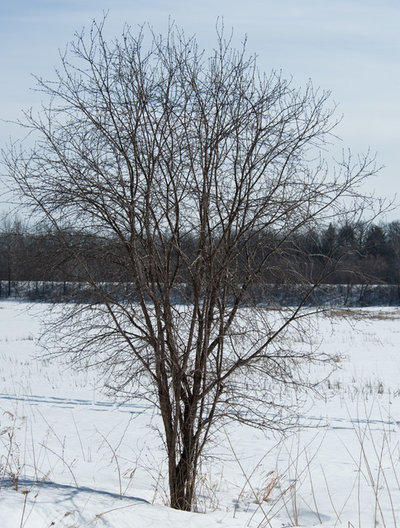
Holm Design & Consulting LLC
How to Identify Common BuckthornThe best time of year to identify common buckthorn is late fall after the deciduous native trees and shrubs have shed their leaves. Common buckthorn loses its leaves much later than native species, remaining dark green into late fall.
Botanical name: Rhamnus catharticaCommon names: Common buckthorn, European buckthorn
Origin: Native to Europe, Africa and Asia from Great Britain and southern Scandinavia eastward to Mongolia; in Africa, native to Morocco and Algeria
Distribution in North America: Present from Washington eastward to Maine in the north and from Utah to North Carolina in the south; occurs in Canada from Alberta eastward to Nova Scotia
Habitats invaded: Woodland edges, understories, old fields and gardens
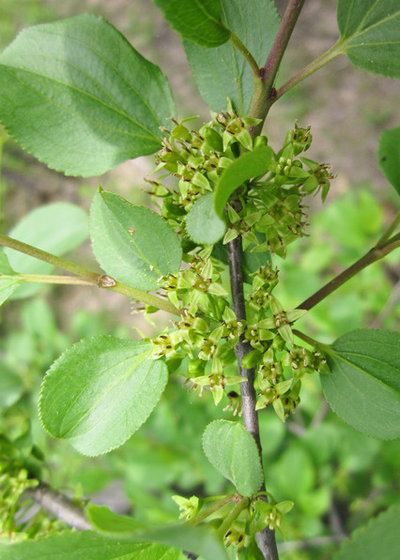
Holm Design & Consulting LLC
Form: Common buckthorn is a large shrub or small tree. Mature plants can be either single-stemmed or multistemmed. It has an upright form with an oval crown.
Mature size: 35 feet tall
Flower: Common buckthorn produces plants with either all male flowers or all female flowers. The four-parted lime green or yellow flowers open in May through mid-June (earlier southward).
Leaf: The medium to dark green oval leaf has prominent arced veins that curve toward the leaf tip. The leaf edge is serrated.
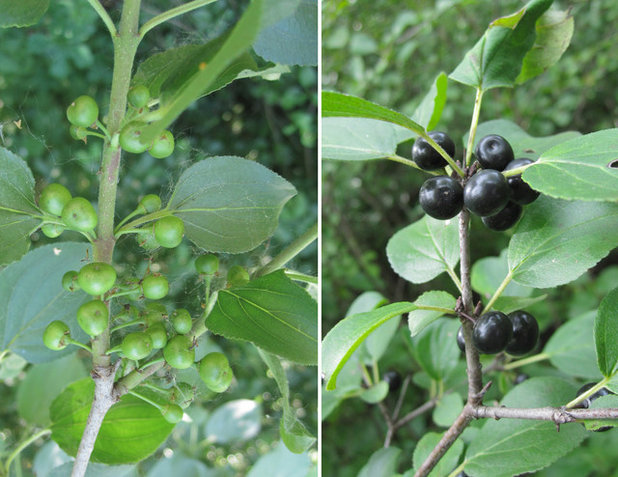
Holm Design & Consulting LLC
Fruit: The drupes are round and berry-like. The immature green fruit (left) matures to dark blue or black (right) at the end of August or September and persists on the plant after the leaves drop in late fall.
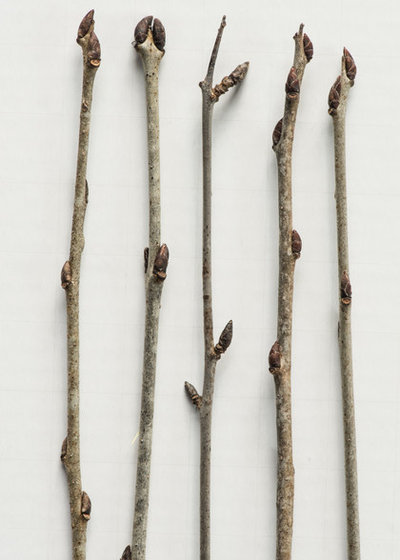
Holm Design & Consulting LLC
Buds: Common buckthorn has a mixture of bud arrangements ranging from opposite, subopposite to alternate on a single branch. At the end of a stem or branch, a thorn-like woody appendage is often present (see center stem in photo).
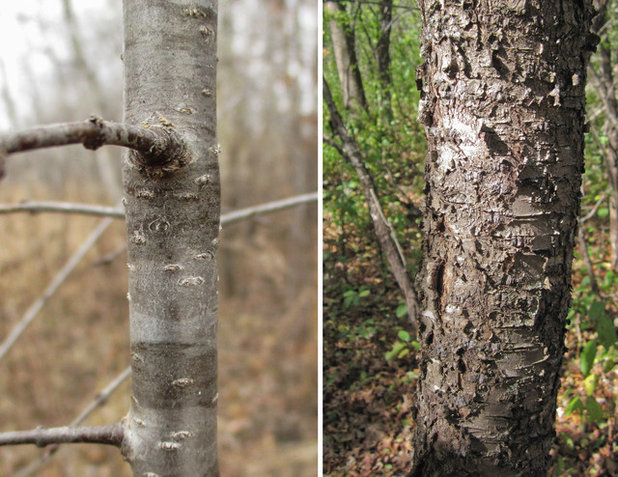
Holm Design & Consulting LLC
Immature bark (left): Immature plants have smooth gray bark with horizontal white or cream lenticels (raised pores in the stem).
Mature bark (right): Mature specimens have peeling, scaly gray bark. The bark is similar in appearance to that of the native black cherry tree (
P. serotina).
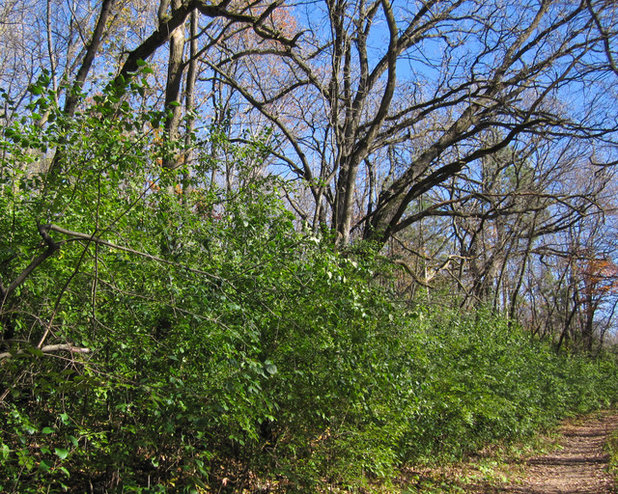
Holm Design & Consulting LLC
How to Prevent Common Buckthorn From Spreading
How it spreads: Berry-feeding birds, including American robins, feed on the fruit in late fall through winter. The seeds pass through their guts and are dispersed into new areas through their droppings. Female trees also produce many seedlings from the fruit.
Control strategies: Depending on the quantity and size of the buckthorn, control measures will vary. Any buckthorn more than 2 feet tall will require cutting the stems or trunk down to the ground, then applying a herbicide with the active ingredient Triclopyr or Glyphosate to the cut stump within 15 minutes. Small seedlings can be pulled by hand or cut and treated like the larger plants. Nonchemical methods include covering the cut stumps with a black plastic bag for one year and girdling. Girdling works well on male trees (not berry-producing).
Removal strategies:1. Do not clear-cut a large area if it’s more than you can manage with follow-up maintenance. Instead, work on removing buckthorn over a multiyear timeline, limiting the amount of disturbance and opportunity for other invasive plants to move in to the area.
2. Identify and clearly mark, with marking tape or something similar, any native plants in the area before starting to remove buckthorn. Cut competing buckthorn around native plants identified to release them from competition.
3. Remove female (berry-producing) buckthorn plants first, followed by plants competing with native plants and finally male plants.





